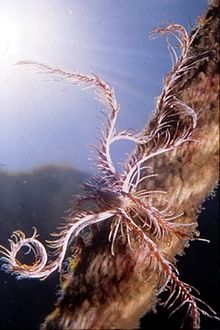Hair stars
| Hair stars | ||||||||||||
|---|---|---|---|---|---|---|---|---|---|---|---|---|

Schlegeli's hair star ( Comaster schlegeli ) |
||||||||||||
| Systematics | ||||||||||||
|
||||||||||||
| Scientific name | ||||||||||||
| Comatulida | ||||||||||||
| Clark , 1908 |
The hair stars (Comatulida) are one order of the sea lilies and hair stars (Crinoidea) and represent the most recent species of the group with around 550 species . Like all echinoderms, hair stars occur only in the sea. However, they are absent on the west coast of Africa and in the eastern Pacific.

features
In contrast to the sea lilies, the hair stars are only stalked in their youth, as the pentacrinus stage . Adult hair stars are free to move and can creep, walk, and some species also swim. Nevertheless, they live hemisessile and are mainly found on exposed, elevated locations on stones, corals or sponges.
The body of adult hair stars can be divided into a small, almost round trunk, the tentacles and the cirrus. In the trunk are the intestines, on the upper side of the trunk the usually slightly eccentric to the edge of the mouth and the anus. On the underside of the body are the claw-like cirrus, which are used for clinging and walking. They are articulated and very flexible. The articulated tentacles arise on the sides of the trunk. They are almost always bifurcated and often have multiple branches. They are covered with feathers (pinnulae) on both sides. The tentacles are not only used for food acquisition, in them, more precisely in special genital feathers, are also the sex organs. Some species lack the cirrus. With them, the shortened lower tentacles take on the task of holding on. Hair stars are usually very colorful.
Way of life
Most hair stars live as filter feeders and suspension feeders in shallow ocean zones with strong currents. However, because of their fragility, they avoid the intertidal zone. Only a few species live in the deep sea. They are shy of light and hide in caves and shady crevices with rolled arms during the day. At dusk they leave their hiding place, climb an elevated position and spread their tentacles in a fan shape to catch plankton. They prey on detritus , diatoms , unicellular algae, small crustaceans and other tiny planktonic organisms. The night activity of the hair stars is an adaptation to the vertical migration of the plankton , which for the most part spends the day in deeper layers of the sea and rises to the sea surface at night. Since hair stars consist mainly of their calcareous skeleton and are not very nutritious, they have hardly any enemies and are only eaten by a few fish and a few lobsters . Colorful hair stars caught by humans occasionally end up in the aquarium trade. As filter feeders, however, they cannot be kept alive for long and usually starve to death within half a year.
Hair stars are inhabited by a whole range of commensals and parasites . These include myzostomids , bristle worms , copepods and shrimp . These sub-tenants are usually well camouflaged and show the color of their host. They feed primarily on the gummed food pulp that the hair stars on their arms lead to their mouths in a channel. Furthermore, they serve as hiding places for various fish, including young lionfish .
Systematics

They are divided into two sub-orders, about 14 families and 90 genera. Together they contain over 500 species.
-
Feather stars (Comatulida) AH Clark, 1908
- Suborder Macrophreata AH Clark, 1909
- Family
- Family Atelecrinidae
- Family Notocrinidae
- Family Pentametrocrinidae
- Suborder Macrophreata AH Clark, 1909
- Suborder Oligophreata AH Clark, 1909
- Family
- Family Charitometridae
- Family Colobometridae
- Family Comasteridae Clark, 1908
- Family Eudiocrinidae
- Family Himerometridae
- Family Mariametridae
- Family Thalassometridae
- Family Tropiometridae
- Family Zygometridae
literature
- Alfred Goldschmid: Crinoida, sea lilies and hair stars. In: Wilfried Westheide, Reinhard Rieger: Special Zoology. Part 1: Protozoa and invertebrates. 2nd Edition. Spektrum Akademischer Verlag, Heidelberg / Berlin 2007, ISBN 978-3-8274-1575-2 , pp. 825-829.
- Harry Erhardt, Horst Moosleitner: Mergus Sea Water Atlas. Volume 3, Mergus-Verlag, Melle, 1997, ISBN 3-88244-103-8 .
- Harry Erhardt, Hans A. Baensch: Mergus sea water atlas. Volume 4, Mergus-Verlag, Melle, 1998, ISBN 3-88244-023-6 .
- Harry Erhardt, Hans A. Baensch: Mergus sea water atlas. Volume 5, Mergus-Verlag, Melle, 2000, ISBN 3-88244-115-1 .
Individual evidence
- ↑ A. Goldschmid: Crinoida, sea lilies and hair stars. In: W. Westheide, R. Rieger: Special Zoology. Part 1: Protozoa and invertebrates. Spectrum Academic Publishing House, Heidelberg / Berlin 2007, pp. 824–825.
Web links
- C. Messing, H. Hansson: Comatulida. World Register of Marine Species. 2010, accessed July 9, 2010.
- Integrated Taxonomic Information System Comatulida AH Clark, 1908